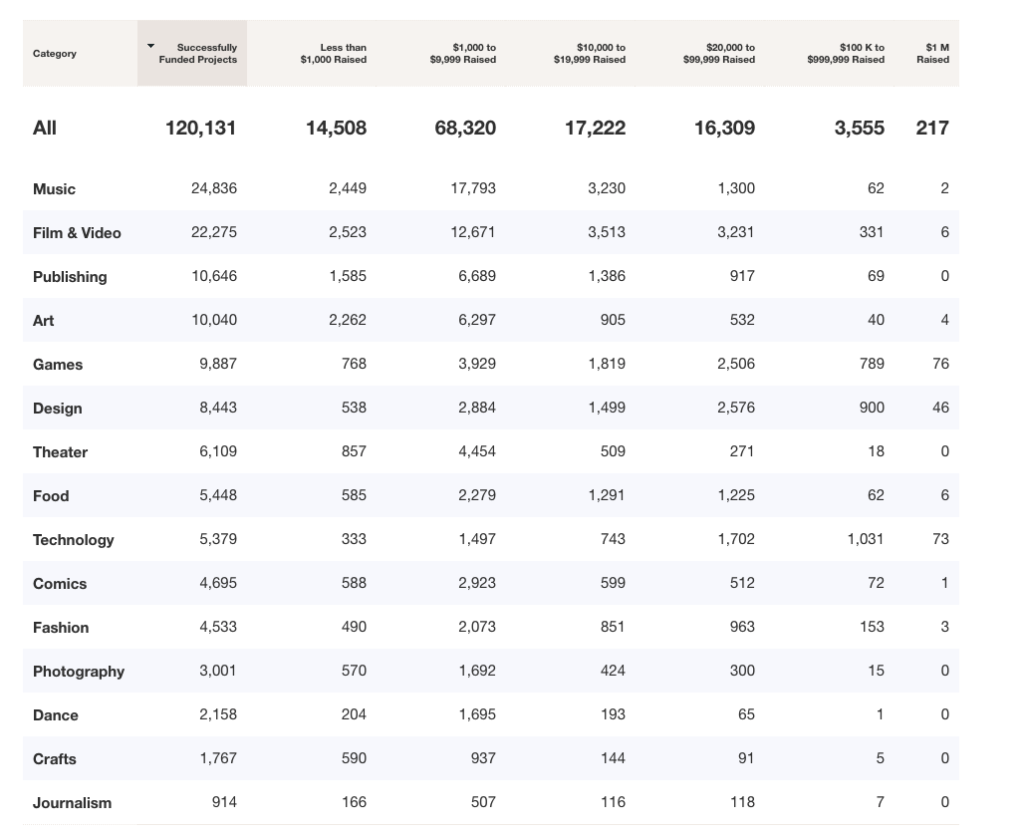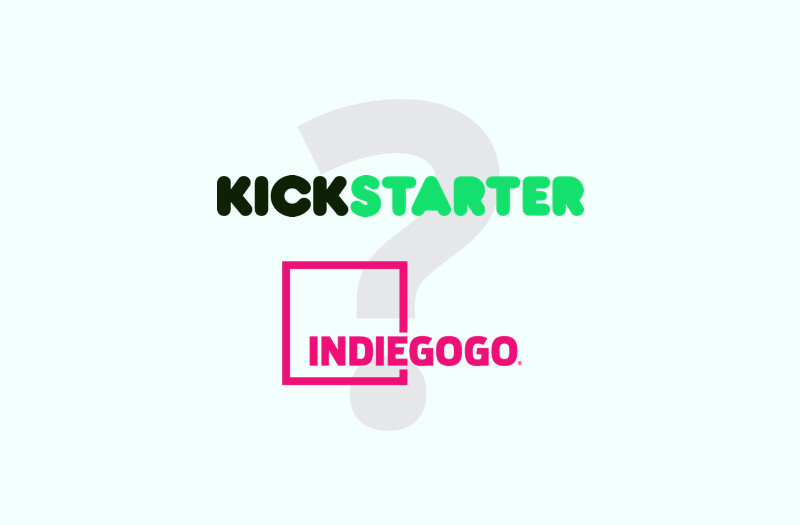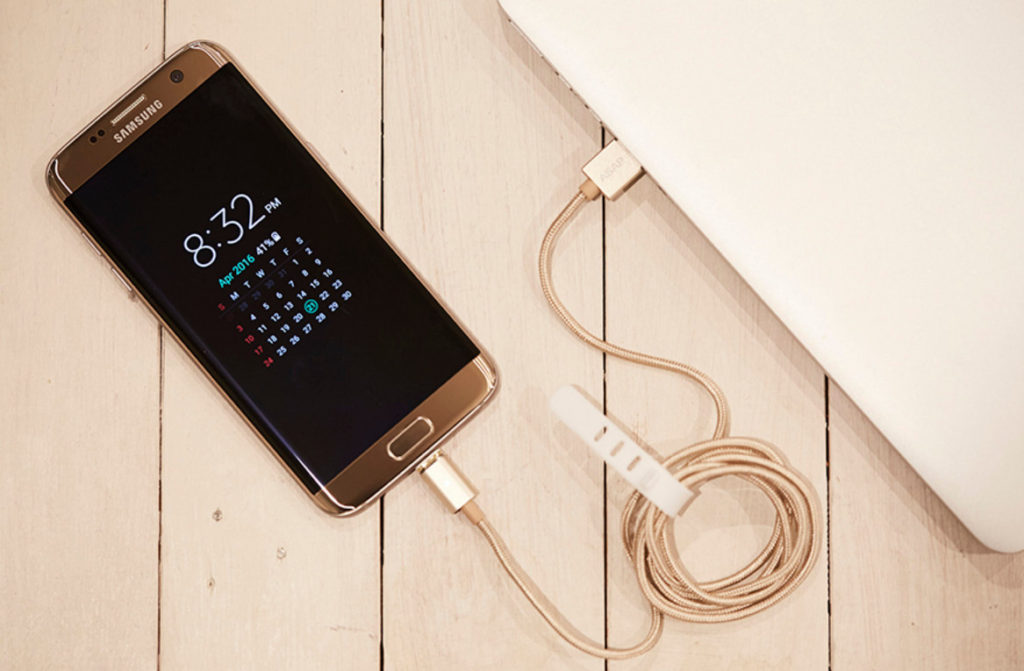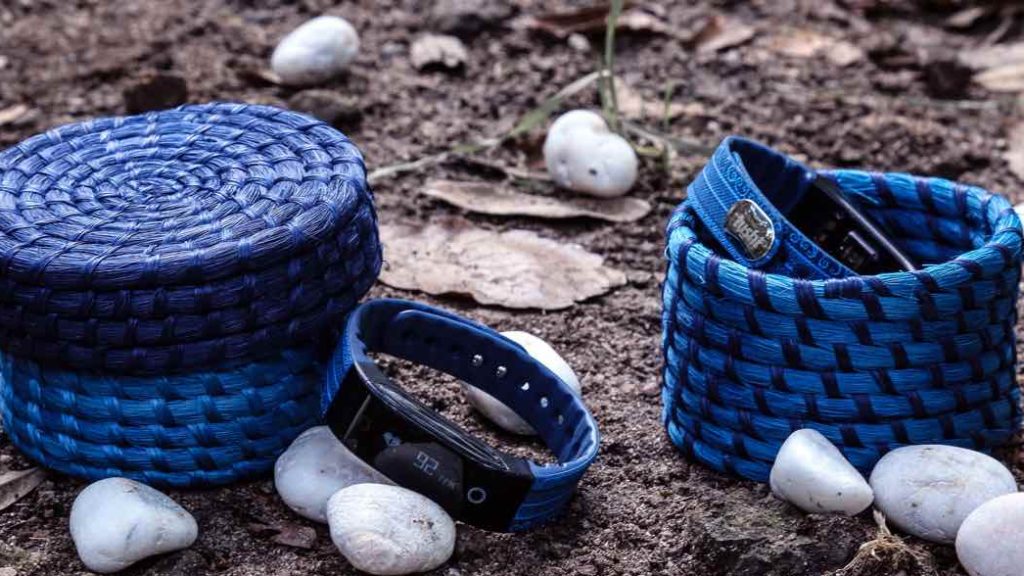Kickstarter and Indiegogo are the two most popular rewards-based crowdfunding platforms. Each has a unique set of strengths: Indiegogo, for instance, has less stringent project requirements, while Kickstarter has a much larger backer community. There are also key differences in the funding models offered by each platform to project creators.
How do you know which crowdfunding platform is right for your project? The following factors will inform your decision:
- Platform rules and requirements
- Platform fees
- Funding models
- Project categories
Kickstarter: Who Can Use It?
The type of project you create can determine which platform you choose for your crowdfunding campaign. Kickstarter has a definitive guide to the types of projects it allows on its site. To date, some $2.8 billion has been pledged on Kickstarter since the platform’s inception. It welcomes projects that fit into the following categories: art, comics, crafts, dance, design, fashion, film & video, food, games, journalism, music, photography, publishing, technology, and theater. (Note: it can’t be used for funding charitable causes or political fundraising.)
Kickstarter prohibits projects that are “illegal, heavily regulated, or potentially dangerous for backers, as well as rewards that the creator did not make”. Prohibited rewards include items such as alcohol, energy food and drinks, weapons, and goods that have been resold from elsewhere. Any projects that are deemed unoriginal or not made by the creator could be suspended.
Kickstarter is open to backers all over the world, but limits project creation to select countries. This list currently includes the US, UK, Canada, Australia, New Zealand, the Netherlands, Denmark, Ireland, Norway, Sweden, Germany, France, Spain, Italy, Austria, Belgium, Switzerland, Luxembourg, Hong Kong, Singapore, and Mexico. More information on eligibility requirements can be found in Kickstarter’s FAQs section.
Kickstarter’s partnership with Stripe integrates the payments process into the crowdfunding platform, making the experience simpler and more seamless for project creators and backers — there’s no need to log in to a separate service. Currently, Stripe can be used by project creators in 25 countries.
Prospective Kickstarter projects are subject to a thorough review process undertaken by Kickstarter’s staff before they are given the green light. This filtering may seem off-putting to some project creators, but the rigorous standards serve as a guarantee of project quality and credibility for backers.
Kickstarter also requires project creators to have a functional prototype for any tangible products on offer. Again, this might seem like more preparation for project creators, but it can also work to their advantage, demonstrating their trustworthiness and commitment to delivering on their campaign promises.
Campaigns on Kickstarter can last between one and 60 days, but the company’s stats suggest 30-day campaigns are more likely to hit the funding sweet spot. There are some psychological reasons for running a shorter campaign: it helps to create feelings of urgency and scarcity, which act as psychological motivators for backers to donate quickly to avoid missing out.
That said, it’s not a hard and fast rule. Podo Labs co-founder Eddie Lee says that provided you have the resources, there’s no downside to committing to the full 60 days. “The lull is the lull no matter what,” he says. “The beginning and end are extremely high-converting, so it’s just more time to draft traffic. There’s no real reason for a 30-day campaign, except if you’re just doing it on the side.”
All or Nothing
All projects on Kickstarter adhere to an ‘all or nothing’ funding model. If a project creator fails to meet the funding goal by the end of the crowdfunding campaign period, the creator will not receive any funds. This allows backers to pledge with confidence because they know that they will only be charged if the campaign meets its funding goal.
Nevertheless, backers and creators alike view Kickstarter as the flagship crowdfunding platform. Its brand recognition is unparalleled; According to veteran project creator and publisher of Dark Regions Press Chris Morey, Kickstarter gets about 300% more unique visitors as Indiegogo does on a monthly basis. Many first-time project creators have contributed to Kickstarter campaigns in the past, which means they are already familiar with what the platform offers.
Kickstarter Design & Technology Outreach Lead Clarissa Redwine told BackerKit that Kickstarter is approaching $1 Billion pledged in design and technology categories and “over 110 projects have raised more than $1M in these categories, 33 in 2016 alone.”
Arthur Maitre, e-commerce manager of product design company Native Union, says he had contributed to Kickstarter campaigns long before he started working at the company. He was drawn to the platform because of its dynamic community, and saw it as a natural fit for Native Union’s JUMP and ECLIPSE cable campaigns. “The community on the Kickstarter tends to be a little more vocal,” he says. “There’s a lot more communication, and we really enjoy that about the crowdfunding process.”
Maitre says the priority for both campaigns was to have a strong showing in the first 24 hours. “The more momentum your campaign gets early on, the better it is for the popularity ranking, the press coverage, and everything that follows.”
Redwine adds that many famous brands started on Kickstarter: “Kickstarter is the most respected and trusted funding platform. If you are working to build a trusted brand, the brands you associate with matter. Kickstarter is proud to have helped companies like Oculus and Form Labs bring their first products to life, and to be on-going part in the journeys of companies like 3Doodler, Lomography, Moment, and Spark.”
Indiegogo: An Open Platform
Like Kickstarter, prospective project creators on Indiegogo must first ensure their crowdfunding campaign satisfies the company’s terms of use. Indiegogo has 24 categories spanning tech, film, design, animals, community, environment, health, politics, religion, small business and sports, to name a few. Unlike Kickstarter, Indiegogo staffers don’t play a role in project creation: Indiegogo’s CEO has said that platform had to be “open without judgement or gatekeepers”. As a result, the volume of projects launched on Indiegogo exceeds that of Kickstarter, although the latter receives a greater volume of pledges.
Indiegogo offers support for more countries than Kickstarter. It is available for project creators in 224 countries and territories around the world, and supports PayPal as a form of payment. Campaign owners residing in the US only need to confirm and verify their PayPal account to make payments on Indiegogo, but restrictions can apply to campaign owners in other countries. For instance, the platform advises that project creators in the Asia-Pacific use credit cards rather than PayPal if funding personal causes; in Europe, campaign owners cannot receive more than 2500 euros in funds, and may need to establish proof of identity to get the account limit lifted.
Indiegogo was first designed as a platform to raise money for film and entertainment products. It continues to be a powerhouse in these categories, as well as for technology products. It’s easier for creators to launch a campaign on Indiegogo because it supports a larger number of countries and has more relaxed campaign requirements compared to Kickstarter. Indiegogo does not require project creators to have a working prototype before their campaign launch, offers a choice between ‘all or nothing’ or flexible funding models, and has a less stringent vetting process for prospective project creators.
Vinson Leow, founder of ASAP Technologies, is a passionate advocate of Indiegogo for crowdfunding campaigns. Leow says the Gogofactor — Indiegogo’s algorithm for selecting projects to feature in its newsletter — gives crowdfunding campaigns a great publicity boost. “They will feature you in their newsletter if you hit certain targets,” he said. “I’ve found that to be incredibly beneficial — it’s resulted in an increase of anywhere between 10,000 and 50,000 extra visits to our campaign page.” The Gogofactor also affects search rankings and inclusion in press outreach.
Indiegogo also offers organizations the opportunity to partner with Indiegogo to mentor and sponsor campaigns, and provides an equity crowdfunding service with Microventures that allows anyone to have a financial stake in a range of innovative start-ups.
Arturo Arvizu, CEO of TushiRocks and creator of the TushiPal fitness tracker, chose to switch his crowdfunding campaign from Kickstarter to Indiegogo. “When we started on Kickstarter, we set a goal of $60,000. After three or four days we realized that it was going to be difficult to reach it.” The second time around, he decided to make some significant changes to his campaign strategy: he would relaunch the TushiPal on Indiegogo for a 30-day campaign, lower the funding goal to $15,000 and adopt a flexible funding model. The tactic worked: the TushiPal exceeded its goal by 128%.
Flexible Funding: Pros and Cons
Indiegogo’s biggest point of difference from Kickstarter is the flexibility it offers in funding models. Project creators can adopt a conventional ‘all or nothing’ approach or choose to ‘keep it all’, which means they can retain any funds raised even if the crowdfunding campaign falls short of its target.
Arvizu says flexible funding made sense for the Tushi Pal, which is both a tech product and social enterprise designed to empower Mayan artisans and create jobs for artists. He says Indiegogo’s function as an “open platform for social products” seemed the perfect fit.
The appeal of flexible funding is obvious for project creators, but carries additional risks for backers, who are typically more willing to fund all-or-nothing projects because they know they will get their money back if the campaign fails to meet its funding goal.
This sentiment is borne out by a recent study that suggests all-or-nothing models “offer a guarantee to the crowd that the entrepreneur does not start a project with unrealistically low funding”. The success of all-or-nothing models may be due to the phenomenon of ‘social proof’: the more backers a project acquires, the more credibility it establishes — a popular campaign signifies a greater likelihood of success.
Moreover, campaigns with an all-or-nothing model were more likely to meet their funding targets: 34 percent of their campaigns were successfully funded, compared to 17 percent of keep-it-all campaigns. In addition, they attracted more backers, netting an average of 188 to 73 for keep-it-all campaigns. That said, the study suggests keep-it-all models can offer value for entrepreneurs that can “scale their business”.
Indiegogo’s mixture of flexible funding and all-or-nothing models make success rates harder to calculate, and it does not publish its key metrics publicly. The Art of the Kickstart and Shopfiy estimate Indiegogo’s success rate to be 17%. Project creators should bear in mind that if they cannot deliver their project with the capital they have raised, they have a moral duty to refund their backers.
InDemand
Sometimes it makes sense for project creators to leverage the advantages of both platforms for a campaign — they might raise funds for their crowdfunding campaign through Kickstarter and raise additional money through Indiegogo InDemand once the campaign has ended.
Indiegogo’s InDemand allows project creators to raise funds after their initial crowdfunding campaign has concluded. There’s no fundraising target or deadlines, so your post-campaign fundraising can last for as long as you like.
Maitre says “there was still quite a bit of interest” for the products in the hours and days after the Kickstarter campaigns had finished. The Native Union website saw a huge spike in traffic in the last two hours of the campaign, and received many emails from people who had missed out on contributing while the Kickstarter was still live.
“We needed a platform for people to be able to pre-order the ECLIPSE so they’re the second group of people to get it after the Kickstarter backers and before the product goes to market,” Maitre says. So, the company chose to use Indiegogo’s InDemand, which allows project creators to raise money for an indefinite period once a crowdfunding campaign has run its course.
Platform Fees and Payments
Kickstarter and Indiegogo share a similar fee structure. At Indiegogo, project creators on a flexible funding model must pay a platform fee of 5 per cent of total funds raised, irrespective of whether the campaign funding goal is reached. project creators that don’t meet their funding target and have a fixed funding model pay no fees, as all money is returned to backers.Then there are third party fees associated with processing credit card payments, wire fees, and transfer costs from Stripe. In general, PayPal charges between 3-5% while traditional credit cards charge a flat 3%.
There are also additional platform fees for InDemand. Project creators who ran their initial campaign on Indiegogo pay 5%; those who ran campaigns on other platforms pay 8%. The charge is higher still if you ran a campaign on another platform and request additional support from Indiegogo.
Meanwhile, Kickstarter’s fees may change depending on the location of your company. For example, project creators in the United States pay a 5% platform fee and between 3% and 5%
in payment processing charges plus $0.20 per pledge. In Singapore, for example, project creators pay 5% of their total funds raised and processing fees of 4% plus $S0.30 per pledge. Head over to Kickstarter’s fee page to see each country’s fee structure.
Category Strengths
Another major differentiator to research is the strength of the community for your particular project category on each platform.
Games, technology, and design projects receive the lion’s share of funding on Kickstarter, although the platform has also proved popular for film and video, music and publishing projects. The most funded projects on Kickstarter span numerous categories: they include the Pebble smartwatch, card game Exploding Kittens, the Baubax travel jacket, and a reboot of Mystery Science Theater 3000, to name a few.
Kickstarter supplies a breakdown of funding for each category on its website.

Indiegogo’s strengths are in technology and design products, mass manufacturing, and charitable causes. More information about its success stories can be found here.



